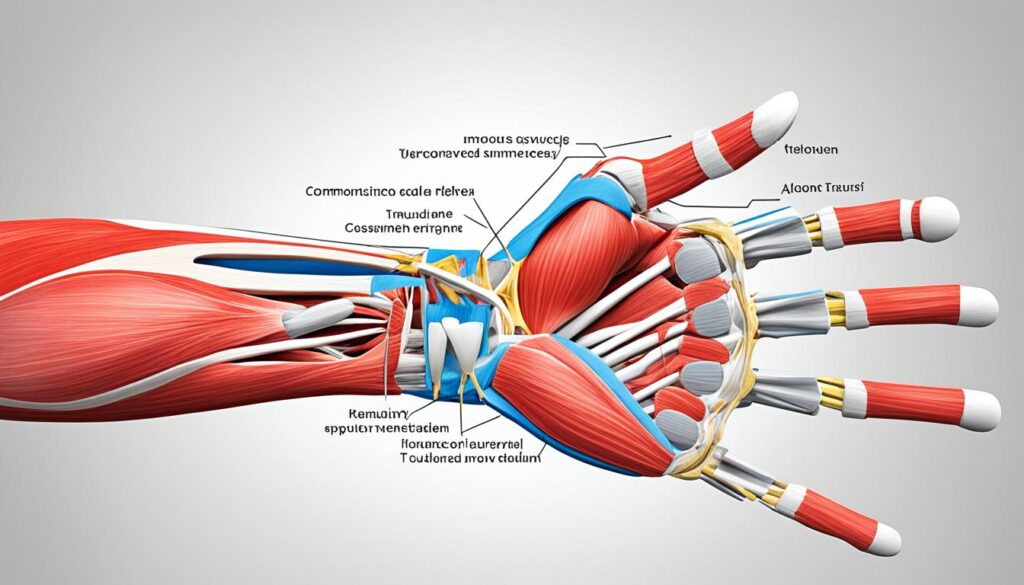When it comes to strong and well-defined arms, the biceps and triceps are two muscle groups that play a crucial role. Understanding the functions of these arm muscles and how to effectively train them is essential for achieving optimal results in your workouts.
The biceps, consisting of two heads, are responsible for flexion of the elbow joint, forearm supination, and shoulder elevation. On the other hand, the triceps, with three heads, are involved in extension of the elbow, stabilizing the shoulder, and shoulder extension. While the biceps are generally more visible and often considered a symbol of strength, the triceps actually make up a larger portion of the arm muscle mass.
Building strong biceps and triceps requires a combination of targeted exercises, proper form, and progressive overload. By incorporating a variety of biceps and triceps exercises into your workout routine, you can effectively develop both muscle groups and achieve more balanced arm muscle development.
Key Takeaways:
- Biceps are responsible for flexion of the elbow joint, forearm supination, and shoulder elevation.
- Triceps are involved in extension of the elbow, stabilizing the shoulder, and shoulder extension.
- The biceps are smaller in size compared to the triceps.
- To build biceps and triceps strength, incorporate a variety of exercises targeting each muscle group.
- Proper form, progressive overload, and regular training sessions are essential for arm muscle development.
Biceps Training
To effectively train the biceps, it is recommended to include a variety of exercises in your workout routine. This will help target different areas of the biceps and stimulate muscle growth. Here are some exercises you can incorporate into your biceps workout:
- Barbell Curls
- Alternating Dumbbell Curls
- Cable Curls
- Machine Preacher Curls
- Incline Dumbbell Curls
- EZ Bar Curls
- Dumbbell Hammer Curls
- Dumbbell Spider Curls
- Drag Curls
- Resistance Band Curls
Beginners can start with 2-3 working sets per session, focusing on proper form and gradually increasing the weight. Intermediate and advanced trainees may need 4-6 sets to challenge their muscles and promote growth. Remember to choose a weight that allows you to complete the desired number of reps with good form.
When performing biceps exercises, it’s important to maintain control throughout the movement and avoid using momentum to lift the weight. This will ensure that the biceps are properly activated and targeted.
For optimal results, it is recommended to work your biceps at least twice per week. This will provide enough stimulus for muscle growth and allow for adequate recovery between sessions.
Sample Biceps Workout
To help you get started, here’s a sample biceps workout that incorporates some of the exercises mentioned above:
| Exercise | Sets | Reps |
|---|---|---|
| Barbell Curls | 3 | 8-10 |
| Alternating Dumbbell Curls | 3 | 10-12 |
| Machine Preacher Curls | 3 | 8-10 |
| Cable Curls | 3 | 10-12 |
Remember to warm up before starting your workout and cool down afterwards. Stretching your biceps at the end of your workout can also help improve flexibility and reduce muscle soreness.
Triceps Training
In order to build strength and definition in your arms, it is essential to include triceps training in your workout routine. Targeting the triceps will not only help you achieve balanced muscle development but also improve your overall arm strength.
Here are some highly effective triceps exercises that you can incorporate into your triceps workout:
- Barbell Skull Crushers
- Machine Triceps Extensions
- Dips
- Dumbbell Kickbacks
- Resistance Band Pushdowns
- Cable Pushdowns
- Cable Overhead Extensions
- Dumbbell Skull Crushers
- Resistance Band Extensions
- Seated EZ Bar Triceps Extensions
These exercises target the triceps from various angles, ensuring that you engage all three heads of the muscle group for efficient growth and development.
If you are a beginner, starting with 2-3 sets per triceps workout session can be sufficient. As you progress and become more advanced, you may need to increase the number of sets to continue challenging your triceps muscles and promote further growth.
| Exercise | Description |
|---|---|
| Barbell Skull Crushers | Lying on a bench, hold a barbell with an overhand grip and extend your arms vertically. Lower the barbell towards your forehead by bending your elbows and then extend them back up. |
| Machine Triceps Extensions | Sit on a triceps extension machine and grip the handles with your palms facing down. Extend your arms fully and then slowly bend them to return to the starting position. |
| Dips | Using dip bars or parallel bars, support your body weight and lower yourself by bending your elbows. Push back up to the starting position. |
| Dumbbell Kickbacks | Hold a dumbbell in one hand with your palm facing your torso. Extend your arm behind you, keeping it close to your body. Return to the starting position and repeat with the other arm. |
| Resistance Band Pushdowns | Attach a resistance band to a high anchor point and grasp the band with your palms facing down. Extend your arms downward, engaging your triceps. Return to the starting position. |
Remember to focus on maintaining proper form and technique during each exercise to maximize the effectiveness of your triceps training. Gradually increase the weight or resistance as you become stronger and more comfortable with the exercises.
Incorporating these triceps exercises into your workout routine will help you achieve well-rounded arm development and enhance your overall strength and stability.
Training Principles for Each
Both the biceps and triceps should be trained regularly for optimal muscle growth. When it comes to biceps training, incorporating a variety of rep ranges is key. Aim for 6-12 reps per set to stimulate muscle growth. Beginners can start with 2-3 sets per session, while those at an intermediate or advanced level may require 4-6 sets for maximum results.
Similarly, the triceps also benefit from a range of rep ranges, typically between 6-12 reps per set. This helps target the different heads of the triceps and promotes overall muscle development. To achieve the best results, it is recommended to train the triceps at least twice a week.
By implementing these training principles, you can effectively target and strengthen both your biceps and triceps, leading to well-developed arm muscles. Remember to gradually increase the intensity of your workouts and listen to your body to avoid overexertion and injuries.
Which is Easier to Train?
When it comes to training the biceps and triceps, some individuals may wonder which muscle group is easier to train. While there is no scientific data to definitively answer this question, it is worth considering certain factors when evaluating the ease of training each muscle group.
Many argue that the biceps are slightly easier to train compared to the triceps. This is because there is a wide variety of curling variations available that primarily target the biceps, such as barbell curls, dumbbell curls, and cable curls. These exercises allow for easy isolation and focus on the biceps, making them easier to train for some individuals.
On the other hand, the triceps consist of three heads, each with different functions, namely the long head, lateral head, and medial head. To effectively train the triceps, one must consider targeting each head with pressing and pushdown movements. This requires a bit more consideration and planning in terms of exercise selection and execution.
That being said, with access to a well-equipped gym and various training modalities, it is entirely possible to effectively target and train both the biceps and triceps. By incorporating a mix of exercises that target each muscle group, individuals can achieve balanced arm muscle development.
The Importance of Balanced Training
Although the debate between the ease of training biceps and triceps exists, it is crucial to emphasize the importance of training both muscle groups. Neglecting either the biceps or triceps can result in muscle imbalances, which may lead to poor posture, decreased performance, and increased risk of injury.
A well-rounded arm training routine that incorporates exercises for both the biceps and triceps can help build strength, increase muscle definition, and improve overall arm aesthetics. Therefore, it is recommended to focus on training both muscle groups equally to achieve optimal results.
To further illustrate the importance of balanced training, let’s take a look at a comparison table showcasing some popular biceps and triceps exercises:
| Biceps Exercises | Triceps Exercises |
|---|---|
| Barbell curls | Skull crushers |
| Dumbbell curls | Machine triceps extensions |
| Cable curls | Dips |
| Incline dumbbell curls | Dumbbell kickbacks |
| EZ bar curls | Resistance band pushdowns |
As you can see, there is a wide range of exercises available for both the biceps and triceps. By incorporating a combination of these exercises into your training routine, you can ensure balanced development and maximize your arm muscle growth.
In conclusion, while the biceps may be considered slightly easier to train due to the wide variety of curling variations, it is important to prioritize balanced training and target both the biceps and triceps in your workout regimen. By doing so, you can achieve well-rounded arm muscle development and enhance overall strength and aesthetics.
Common Injuries
Both the biceps and triceps are prone to injury, either from acute trauma or chronic overuse. It is crucial to be aware of common arm muscle injuries to take the necessary precautions and prevent further damage.
Biceps Injuries
- Bicep Tendonitis: This condition occurs when the tendons of the biceps become inflamed, leading to microtears in the tendon. It is often characterized by pain and tenderness in the front of the shoulder or elbow.
- Bicep Tears: Bicep tears can range from partial tears to complete ruptures of the biceps tendon. These injuries can result from sudden forceful movements or heavy lifting.
Triceps Injuries
- Tricep Tendonitis: Tricep tendonitis primarily affects the distal triceps tendon near the elbow. It is typically caused by repetitive motion and can result in pain, swelling, and limited range of motion.
- Tricep Tears: Similar to bicep tears, tricep tears can also be partial or complete tears of the triceps tendon. These injuries can occur during activities that involve forceful extension of the arm.
To reduce the risk of biceps and triceps injuries, it is important to maintain proper form during exercises and gradually increase intensity over time. It is also advisable to start with lighter weights and focus on building strength gradually. If you experience persistent pain or suspect an injury, consult a healthcare professional for an accurate diagnosis and appropriate treatment.
| Biceps | Triceps | |
|---|---|---|
| Common Injuries | Bicep Tendonitis, Bicep Tears | Tricep Tendonitis, Tricep Tears |
| Cause | Acute trauma, chronic overuse | Acute trauma, chronic overuse |
| Symptoms | Pain, tenderness, limited range of motion | Pain, swelling, limited range of motion |
| Treatment | Rest, physical therapy, surgery (severe cases) | Rest, physical therapy, surgery (severe cases) |

Conclusion
The biceps and triceps play crucial roles in arm muscle function, and incorporating exercises that target both muscle groups is essential for well-rounded arm development. The biceps are responsible for flexion of the elbow joint, forearm supination, and shoulder elevation. On the other hand, the triceps are involved in extension of the elbow, stabilizing the shoulder, and shoulder extension.
To effectively train the biceps, exercises such as barbell curls, dumbbell curls, and cable curls can be incorporated into your workout routine. Similarly, the triceps can be targeted with exercises like barbell skull crushers, dips, and dumbbell kickbacks. Progressive overload, proper form, and listening to your body are important principles to follow for both muscle groups.
While training the biceps may seem slightly easier due to the wide variety of curling exercises available, with the right approach and equipment, both the biceps and triceps can be effectively trained. It is crucial to consult with a certified trainer who can provide personalized guidance and create a well-balanced exercise program to meet your specific needs.
Lastly, to prevent common arm muscle injuries, it is important to maintain proper form, gradually increase intensity, and start with lighter weights. By incorporating biceps and triceps training into your workout routine and following these guidelines, you can achieve balanced arm muscle development and reduce the risk of injuries.
FAQ
What are the functions of the biceps and triceps?
The biceps are responsible for flexion of the elbow joint, forearm supination, and shoulder elevation. The triceps are involved in extension of the elbow, stabilizing the shoulder, and shoulder extension.
How can I effectively train my biceps?
Recommended exercises for biceps training include barbell curls, alternating dumbbell curls, cable curls, machine preacher curls, incline dumbbell curls, and more. Beginners may start with 2-3 working sets per session, while intermediate and advanced trainees may need 4-6 sets for optimal growth.
What exercises should I do to target my triceps?
Recommended exercises for triceps training include barbell skull crushers, machine triceps extensions, dips, dumbbell kickbacks, resistance band pushdowns, and more. Beginners may start with 2-3 sets per session, while more sets may be required for intermediate and advanced trainees.
How often should I train my biceps and triceps?
Both the biceps and triceps should be trained at least twice per week for optimal muscle growth.
Which muscle group is easier to train, biceps or triceps?
While there is no scientific data on which muscle is easier to train, some may argue that the biceps are slightly easier due to the wide variety of curling variations available. However, with access to a well-equipped gym and various training modalities, it is possible to effectively target and train both the biceps and triceps.
What are common injuries associated with the biceps and triceps muscles?
Common biceps injuries include bicep tendonitis and bicep tears, while triceps injuries can include tricep tendonitis and tricep tears. Proper form, gradual increase in intensity, and starting with lighter weights can help reduce the risk of these injuries.
What is the importance of training both the biceps and triceps?
Training both the biceps and triceps is important for balanced arm muscle development and overall functional strength.
How can I prevent common arm muscle injuries during training?
Proper form, progressive overload, and listening to your body can help prevent common arm muscle injuries. It is also advisable to consult with a certified trainer for personalized guidance in creating a well-balanced exercise program for your biceps and triceps.
What are the key takeaways about biceps and triceps?
The biceps and triceps are vital muscle groups in the arm that have distinct functions. They can be effectively trained through a variety of exercises targeting each muscle group. Including both biceps and triceps training in your workouts is important for balanced arm muscle development.







